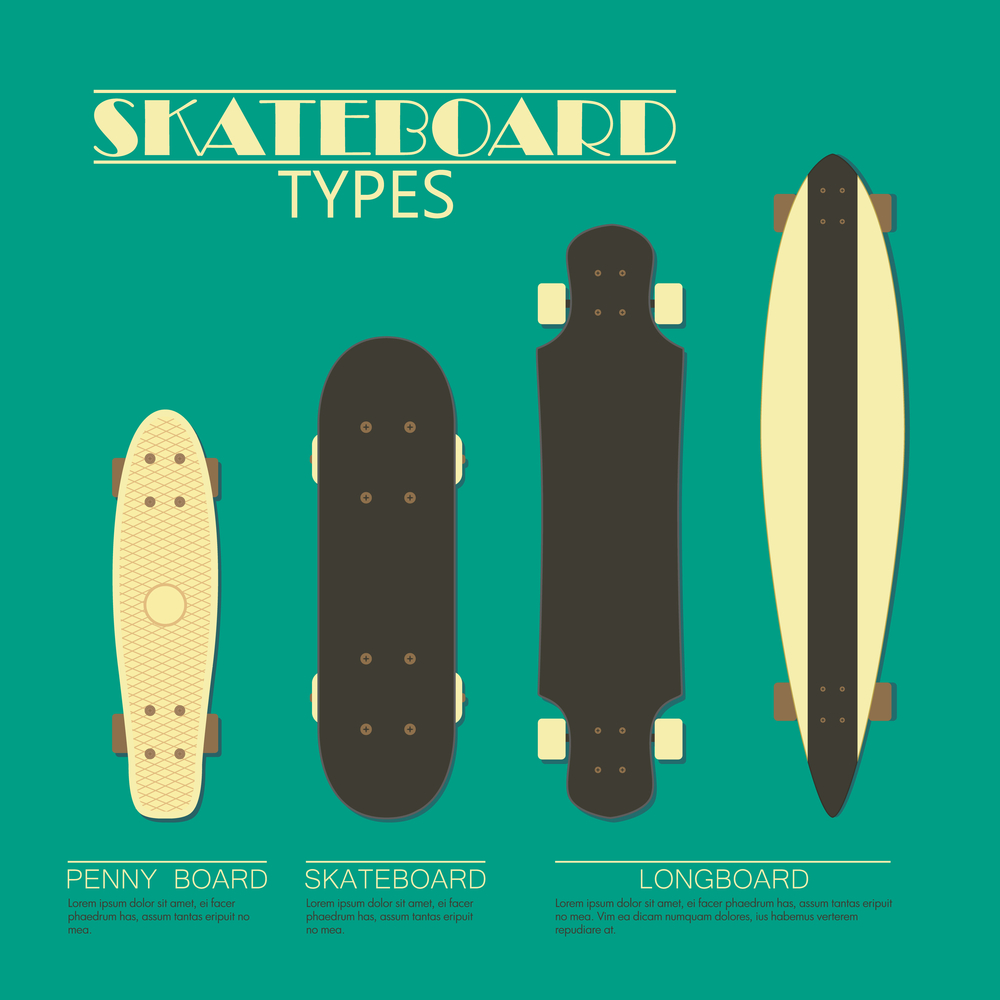While Penny boards are some of the most accessible and affordable skateboards on the market, depending on how you intend to use your new skateboard, you might find yourself perfectly satisfied or particularly frustrated by a Penny board.
The Penny board is an alluring spectacle. The half skateboard, half longboard are some of the most interesting and misunderstood choices for skaters.
That’s exactly why GOSKATE wrote this article–we’ll tell you exactly what a Penny board is, some of their pros and cons, and when and when not to add one to your arsenal.
As always, we invite anyone interested to learn more about skateboarding to follow us on Facebook and Instagram for the latest news and trick tips. Now, let’s GOSKATE!
What is a Penny Board? And How Did it Get it's Name?
If you’re reading this article, you probably have a general idea of what a Penny board is but we’re going to break it down for you like never before.
First and foremost, the name Penny board is an eclipse of the actual product. Like Kleenex, Rollerblades, Walkman, these products were actually brands that eclipsed the notoriety of the product.
The official 2010 Penny board was a brand named after the owner’s sister.

What makes these boards inherently unique is the streamline approach to the design.
The deck of a Penny board is probably what you’ll notice first. Made from plastic, the top of the boards have a waffle top texture, designed for a non-slip surface and flexible ride.
The wheels of the Penny board are an impressively large 59 to 69 mm set. On a hardness scale known as the ‘durometer’ rating, from 65A–100A, Penny board wheels are a solid 85A; making them capable of skating over some of the gnarliest terrain.
Board: Waffle grip, plastic, 22-27 inches
Wheels: 59-69 mm Wheels, 85A hardness

When to Ride a Penny Board
These petite cruisers are more akin to some of skateboarding’s earliest conceptions but with an entirely different purpose.
While both it’s DogTown predecessors and today’s contemporary popsicle-shaped skateboards are meant for maneuvering tricks, Penny boards are made entirely for transportation.

Who Uses Them: A United States census found that the average person for non-motorized transportation was from the ages of 14-24 or essentially high school and college students. Students from these ages choose a wide array of transportation but many choose a Penny board for its size and cost.
Why Use Them: Any time you’re looking to have the speed and mobility of a longboard but with optimal accessibility and maneuverability–you’ll be happy with a Penny.
That is if you can reconcile with some of the Penny board cons or reasons why and where Not to ride a Penny board.
When Not to Ride a Penny Board
Penny boards are a lot of fun and this is reason enough alone to always ride a Penny board.
That being said, there are some instances when riding a Penny board is not ideal or even dangerous.
- For starters, a Penny board is not for doing tricks. So if you’re looking to hit the skatepark or fly off a jump ramp in your local parking lot, these boards are not built for that type of skating.
- The boards do not allow for you to produce an ollie, nor does the plastic deck prove to be viable against impact. Moreover, while a Penny board is built for transportation, it is not necessarily the best option for cruising–like you would on a longboard.
- The reason being a Penny board requires you to place your feet together a lot closer than on a longboard or other skateboards. In doing this, you do not have the maximum stance to lift your nose to maneuver your board (think sidewalk surfing).
- Beginner skaters will find it hard to maintain a core balance, and many new skaters will buy a Penny board and later realize they are too dangerous to maneuver through crowded areas.
- Your first board should probably not be a Penny board unless you intend to learn how to ride it in an empty parking lot or driveway.
What is the Difference Between a Penny Board and a Regular Skateboard?
You might be thinking: four wheels, two trucks and a deck–that’s a skateboard, right?
Technically, you would be correct but as we see from this article and our catalog of insider skateboarder knowledge, not all skateboards are created equal.
For instance, a Penny board and a regular skateboard provide completely different experiences. A regular skateboard is constructed to handle the high-performance demands and trick maneuverability of contemporary skateboarding, whereas a Penny board is for transportation with an emphasis on speed, convenience and accessibility.

A Penny board is a homogeneous plastic deck, whereas a regular skateboard deck is 7 plies of maple wood pressed together with concave curvature.
As we outlined earlier in this article, the wheels of a Penny board are much larger and harder than a regular skateboard’s wheels.
The trucks are also smaller, all of which contributes to a more aerodynamic board for higher speeds.
These differences are precisely why this article was written, but bravo to you for doing the proper research for maximum safety and fun.
How to Ride a Penny Board
Okay, down to the nitty-gritty. Here are some proven tips and techniques to riding a Penny board.

- Push off with your back foot: Pushing with your back foot might seem obvious but many beginner skaters will actually feel more comfortable with taking off their front. However, this causes your shoulders and your hips to misalign and forces you to make excess movements that can cause you to slip or lose balance.
- You’ll need to get in the habit of pushing off your back foot, even if it might feel impossible at first. It will ensure you produce the maximum result with the least effort, and you’ll look much cooler than the ‘mongo’ style associated with posers.

- Feet on the bolts: At first, a lot of skaters will have to put their feet wherever they feel the most balanced but for those of us who still find it difficult, a good rule of thumb is to start with the bolts. Bolts? The top of the screws that go in above the trucks.
- Just like any type of sport or activity, if your legs are farther apart, you’ll gain more balance and stability. With a small nose, be mindful of putting your foot too high.
- Feel for the tail below the bolts, eventually, you’ll want to manipulate that pocket for turning.
- Low Center of Gravity: You know those classic images of DogTown skaters riding tiny boards and ripping downhill or zooming around cones? What do all those photos have in common? Whether it’s Jay Adams or Tony Alva, the skaters are all crouched down low in perfect sidewalk surfing fashion.
- When you stand straight on a Penny, you’re disconnecting your center of gravity between your toes and the top of your head. Bringing these points of gravity all down to your core in a crouch ensures you’re able to deal with any potential hazards of maneuvers on the fly.
- Feeling speed wobbles or approaching a crack-ridden part of the sidewalk? Crouch!
- Know the Speed Limit: What makes Penny boards particularly fun is also what makes them particularly dangerous. These little boards are like lightning bolts, as their large wheels and aerodynamic shape sends you flying down the street.
- For the experienced skater, this makes them the perfect cruiser for afternoon hill bombs or sunset downhill sessions. However, for the beginner who might not understand the 0-60 nature of these boards–you can find yourself with a scraped knee and a sore hip pretty-fast (no pun intended). But if you take into consideration the tips above and our final tip for How to Ride a Penny board, you’ll be more than fine.
- Stop and Pass Go: I can’t tell you the amount of times someone has fallen on a Penny board from failing to stop correctly. The problem is, most people are not used to being on a skateboard, so when they find themselves 4-6 inches above the ground, they put their foot down only an inch or so below, start leaning back (which spells disaster if you’re wearing a backpack) and instead of planting their whole foot on the ground, they maybe get just a toe and boom, the party’s over.
- You must learn to stop well on a Penny board and quickly, as you’ll generally be zipping through crowded areas or schools. A good rule of thumb when it comes to What is a Penny board and How to Ride One: stopping is more important than going.
Do Penny Boards really go faster?
Penny Boards are usually slower than regular skateboard or longboard. The components used to build a Penny board were selected to make it light and cheap, at the cost of stability, speed and control — on the other hand the components on skateboard or longboard are built to keep you safe and in control during higher speed downhill riding.
Tips for Parents
Now that you know exactly what a Penny board is and How to Ride One, we encourage you to call up a few friends and hit the neighborhood.

Truthfully, from a lifelong skateboarder, a Penny board does not belong in the skatepark.
Although many parents will feel like a Penny board is a good first option for their younger kids, in reality, they are better options.
These boards like we said earlier, lack the nose and tail and true maneuverability of actual skateboards. So when you bring your kids to the skatepark with a Penny board and your kid attempts to turn and the board shoots out, it sends a b-line into the park.
This is not only extremely dangerous for the other skaters there but your kids will most likely spend a lot of time chasing after them into harm’s way.
The Penny board is an alluring spectacle. The half skateboard, half longboard is both boards and yet neither all at once, making these skateboards some of the most interesting and misunderstood choices for skaters.
While Penny boards are some of the most accessible and affordable skateboards on the market, they can also be pretty dangerous.
In other words, depending on how you intend to use a Penny board, you might find yourself perfectly satisfied or particularly frustrated by a Penny board.

Sign Up Your Child for Our GOSKATE Lessons!
Penny board or not – Are you interested in more tips for getting your child into skateboarding?
Here is an article on “Tips for Parents at the Skatepark” and some articles on “Introducing Your Child to Skateboarding?”
As always, if you sign up for our skate lessons, our instructors will be there with open arms to catch your kids if they fall. Learning to skate with others expedites the process and adds more fun.
Find out today how you can help gain self-confidence and maintain an active healthy lifestyle by contacting GOSKATE.
Now that you’ve been given some proven tips on Learning How To Skateboard as an Adult, you’re well on your way to accomplishing your skateboard dreams.
Remember, skateboarding is best with friends and we’ve even included some ways you can help meet other beginner skaters in your area.
Either way, have fun and GOSKATE!









![How to Skateboard with your Dog [Best Breeds]](https://www.goskate.com/top/wp-content/uploads/2022/01/Screen-Shot-2022-02-10-at-12.54.16-e1644490564854-80x80.png)




